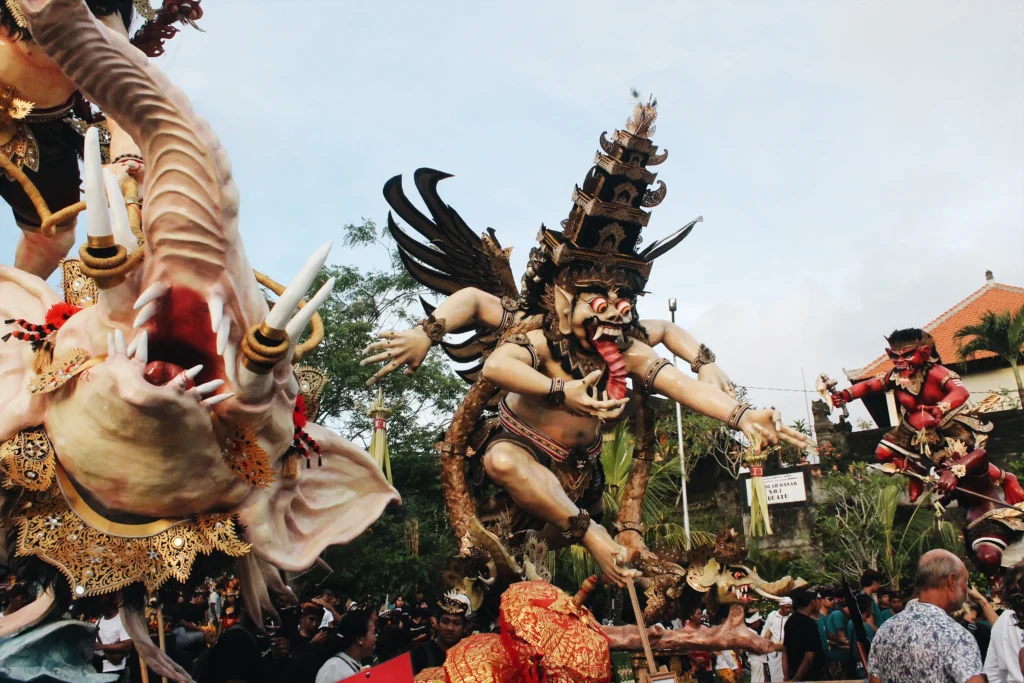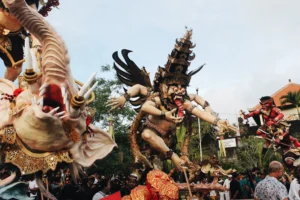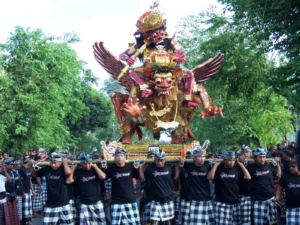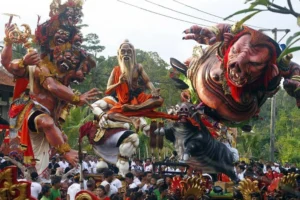As Nyepi 2024 approaches, the population of Bali celebrates the event with enthusiasm and unique traditions. One of the most anticipated moments is the Ogoh-Ogoh ceremony, a colorful and distinctive celebration. This ceremony becomes the focal point for welcoming the arrival of Nyepi, creating a spiritual and cultural buzz that marks the beginning of Nyepi festivities. The meticulously crafted Ogoh-Ogoh statues by the local community embody the richness of Bali’s traditions and mythology. At every step, the Ogoh-Ogoh ceremony invites Bali’s population to participate in a profound experience, fostering unity and cohesion that transcends generational boundaries.
Through the Ogoh-Ogoh ceremony, the people of Bali welcome Nyepi not only as a moment of silence but also as an opportunity to explore their cultural roots. This tradition provides a space for artistic creativity and spirituality, connecting the population to their ancestral heritage. The Ogoh-Ogoh ceremony is not just a visual attraction but an event that imparts life values, solidarity, and spiritual resilience. In this article, we will explore each aspect of the Ogoh-Ogoh ceremony, uncovering its uniqueness and interpreting the hidden meanings behind the gigantic statues adorning the streets of Bali before Nyepi 2024.
1.Ogoh-Ogoh Ceremony History: Recalling Myths and Legends
source: abahgoong.blogspot.com
The Ogoh-Ogoh ceremony in Bali is not just an annual tradition; it is a manifestation of myths and legends closely tied to the island’s cultural identity. Exploring the history of Ogoh-Ogoh takes us back to a time when Balinese society relied heavily on agriculture and the natural elements. Ogoh-Ogoh, as a striking giant statue, is considered a symbol of evil and negative energy to be expelled before the Nyepi celebration.
Each Ogoh-Ogoh statue has a unique design, often inspired by mythological characters from Balinese tradition. Astral creatures and gods playing a crucial role in folk tales serve as inspiration for artists crafting the Ogoh-Ogoh. The process of creating Ogoh-Ogoh is not just technical work; it involves collaboration and creativity from the local community. With enthusiasm, they work together to create a spectacular work of art, showcasing Ogoh-Ogoh that not only reflects the richness of Balinese mythology but also captivates visually during the Nyepi celebration.
2.Ogoh-Ogoh Making: Art and Creativity as a Collective Manifestation
source: coconuts.co
The process of making Ogoh-Ogoh in Bali is not just technical work; it is a celebration of art and creativity deeply rooted in society. Each village becomes a hub of activity for Ogoh-Ogoh artisans with specific skills in sculpting and creating these giant statues. At every stage of production, these artists do not simply replicate the statues but further explore visual arts by adding their artistic touch, creating truly unique Ogoh-Ogoh that reflect Bali’s cultural richness.
The significance of Ogoh-Ogoh lies not only in the final result but also in the collaborative process involving active participation from the local community, especially children and teenagers. They eagerly participate in every stage of Ogoh-Ogoh making, creating moments of solidarity that strengthen community pride.
In this context, making Ogoh-Ogoh is not just a means of preserving local wisdom but also a manifestation of cultural continuity that flows powerfully through the close bonds between younger and older generations. The Ogoh-Ogoh ceremony becomes more than just an annual tradition; it is a cultural celebration rooted in interaction and collective creativity, highlighting Bali’s uniqueness that persists with every Nyepi celebration.
3.Ogoh-Ogoh Parade: a Spectacular Moment during Nyepi Celebration
source: palembang.tribunnews.com
The climax of Ogoh-Ogoh preparations is the impressive parade preceding the Nyepi night. Hundreds, if not thousands, of Ogoh-Ogoh, created with love and dedication by the local population, march through the streets illuminated by torches and colorful lights. This parade not only captivates the eyes but stimulates all the senses of the spectators, creating an unforgettable atmosphere.
Each Ogoh-Ogoh carries a particular message, not only as a symbol of evil to be expelled but also as a reflection of current events and issues faced by the population of Bali. In this parade, one can see how art, spirituality, and social reality are interconnected, creating a profound experience for all who witness it.
4.Significance of Ogoh-Ogoh in the Modern Bali Context
Although the tradition of Ogoh-Ogoh has deep roots in a rich culture, its existence is not independent of the changes of the times. In the context of modern Bali, Ogoh-Ogoh becomes a means of conveying modern messages, addressing issues such as environmental preservation, peace, and social justice. Through Ogoh-Ogoh, the people of Bali demonstrate their ability to adapt to the changes of the times without losing the strength of their cultural roots.
Participating in the Ogoh-Ogoh ceremony is not just about observing an ancient tradition but also understanding how culture can endure and evolve amid changes. This tradition becomes a meeting point between ancestral heritage and the dynamics of modernity, creating an impressive continuity.
5.Role of Ogoh-Ogoh in the Inner Purification Ritual
source : pinterest.com
In Balinese tradition, Nyepi is not only a time to visually celebrate Ogoh-Ogoh but also a period of introspection and inner purification. Alongside the vibrant Ogoh-Ogoh parade, there are rituals in villages involving the community in spiritual processions. Traditional leaders lead prayers and ceremonies designed to purify the mind from negative energies and sins. Ogoh-Ogoh becomes the manifestation of the dark forces to overcome and expel from each individual.
Participating in this ritual gives deep meaning to the Balinese population. Ogoh-Ogoh is not just seen as artistic sculptures but also as spiritual instruments that help purify the soul and achieve spiritual balance. Ultimately, this ceremony becomes a symbol of the life cycle, always involving the struggle between forces of good and evil.
6.Impact of Tourism on Ogoh-Ogoh Ceremony: Drawing Global Attention
With the charm and uniqueness of the Ogoh-Ogoh ceremony, this tradition has captured the attention of the tourism world. Every year, thousands of local and international tourists flock to Bali to witness the spectacular Ogoh-Ogoh parade. The economic impact of tourism related to Ogoh-Ogoh is significant, with increased visits creating jobs and business opportunities in the tourism sector.
However, the growth of tourism also presents challenges. How to preserve the authenticity and spirituality of the Ogoh-Ogoh ceremony without being influenced by commercialization? How to positively involve tourists in preserving Balinese culture without compromising the tradition’s sustainability? These are important questions that the Balinese population and local authorities must address to maintain a balance between tourism growth and culture preservation.
7.Ogoh-Ogoh in the Context of Social and Political Creativity
The Ogoh-Ogoh ceremony, as a form of traditional Balinese art, not only showcases artistic creativity but also illustrates a rich spiritual dimension. In the creation process, artists strive to convey deep messages through every detail of the Ogoh-Ogoh sculptures. Some even address contemporary themes reflecting current social and political issues. Thus, the Ogoh-Ogoh ceremony is not just a cultural celebration but also a means of expressing society’s aspirations regarding current events.
The significance of the Ogoh-Ogoh ceremony in taking a stance on social and political issues has increased in recent years. Some Ogoh-Ogoh sculptures not only reflect climate change or inequality but also express opinions on human rights violations and political problems. Through Ogoh-Ogoh sculptures, Balinese society can artistically and captivatingly convey its political messages. Therefore, this tradition is not just a festive ritual but becomes a way to raise awareness of social and political responsibility.
The Ogoh-Ogoh ceremony, with its political messages, not only produces fascinating artworks but is also part of a broader movement toward social change. The voices emanating from these sculptures are not limited to the local level but reach a global scale, reflecting issues relevant to contemporary world challenges. Thus, through this tradition, art and culture become a force capable of inspiring positive change, uniting society in a broader dialogue about the common future. With the constant evolution of political messages in Ogoh-Ogoh ceremonies, traditional Balinese art remains an effective means of awakening consciousness and building solidarity within society.
Conclusion
Through the exploration of history, the manufacturing process, the parade, and its impacts, we can better appreciate the uniqueness and cultural richness of Bali expressed through the Ogoh-Ogoh ceremony tradition. From a simple local celebration, Ogoh-Ogoh has developed into a symbol of Bali’s global identity, attracting tourists’ attention and serving as a means to address crucial issues.
Participating in the Ogoh-Ogoh ceremony is not just about observing a dazzling visual experience but also reflecting on the meaning behind each giant statue. Plan your trip to Bali with Salut Bali now; we are ready to assist and accompany you during your journey to Bali to witness the Ogoh-Ogoh ceremony and enjoy the natural beauty of the island. Have a great vacation!








